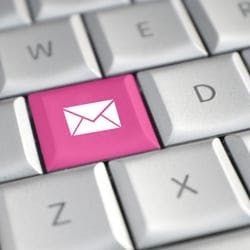eMarketing is one of the most important aspects of a successful inbound marketing campaign, but you need to treat your email subscribers with care if you’d like them to stick around for a while. Here are some eMarketing best practices every business can follow.
After nine weeks, we’re getting close to having finished building a successful inbound marketing strategy. By now, you should have engaged with people on social media and attracted new visitors to your website via Google, who would have exchanged their email address in return for some relevant content you’re offering – which means you should have a growing database.
Many businesses make a critical mistake at this point, by selling to new subscribers as soon as they’ve handed over their email addresses. This is exactly what not to do.
Imagine you’ve been invited to a BBQ at a friend’s house, but when you get there you find out that in addition to having some food and drinks, you’re also faced with a sales presentation for a new product your friend’s company has launched. How cheated would you feel? This is precisely how your email database will feel, if you start selling to them immediately after you’ve given them something for free.
Instead of selling straight away, spend some time getting to know the new people on your list: Ask them questions about themselves or their business, what are their needs or concerns, ask if you can help them and send them valuable information in a timely manner. This process is called lead nurturing, and business that excel at this generate 50 percent more sales-ready leads.
Now before you throw your hands up in the air and shout “Where am I going to get the time to do that?” Just relax. This is where your email system’s automation comes into effect. You can arrange for these follow up messages to be sent out automatically – for example, If a visitor signs up on your website for a free eBook, five days later they can automatically receive an email asking whether they enjoyed the eBook, and a further five days later, you can arrange for them to be sent a video looking at how your business helps people.
Think back to the BBQ analogy. When it comes to eMarketing, it’s a good idea to think naturally about how you engage in normal conversations with people you’ve just met. You would ask things like “How are you?”, “How do you know the host?”, and maybe “Did you have a nice weekend?” Apply the same common sense to your email marketing and you’ll naturally build an engaged community around your company by not selling.
So lets look at some best practices into your eMarketing:
1. Building your List
Make sure your lead forms allow website visitors to enter their email address and opt-in to receive your messages. Two great email marketing platforms are Aweber and Mailchimp, as they can help make sure you’re fully compliant with email policies in your country.
Your website is not the only place you can build your list, ask your friends on Facebook to sign up for your updates, then ask them to forward on your newsletters. When you meet a new person at an event give them your business card and tell them to sign up for your updates on your website – follow up with a reminder via email.
On average, a business loses 25 percent of its email subscribers every year, which makes it vital to keep growing your database – it’s the key to success of your business.
2. Content of your emails
Be personable in your communication. When you capture somebody’s name on your opt-in form, remember to address them in your emails to them. Remind people how they met you or where they signed up by having this information at the bottom of each correspondence.
Always think – “What’s in it for them?” Tell the reader why your email is of value to them. Be consistent with your emails don’t leave it too long between connecting with your list.
3. Have a call to action
Every single one of your marketing messages should have a goal. They all must have a clear call to action, which makes it clear what the reader needs to do if they would like more information from you or if they would like to purchase your products or services.
4. Measuring
Your email software should allow you to analyse what content is most popular with your database. For example, you might send people an eBook about one of your products which gets a large response – allowing you to discover the people on your email list are interested in that topic more than others. Now you know what your audience wants, you need to them what they’re asking for.
Email marketing is one of the last steps in your inbound marketing campaign, and one of the most important. Potential customers have trusted you with something very valuable – their email address – so it’s vital you don’t abuse this privilege bombard them with sales messages. If you abuse it, they’ll unsubscribe and you’ll lose a potential sale and the opportunity to build a long-term relationship with that person who could have otherwise recommended you to others.
If you would like to have an automated email marketing system created for your business, drop us an email titled “Email Marketing” to sales@getfocusedconsulting.com.au and we’ll be in touch to help.

